In praise of the Sun
The sun gives us light and energy. There would be no life on the earth if the Sun did not rise, day after day, without a single day’s rest. People of many civilizations have worshiped the Sun as God since times immemorial. But during the tropical summer, it emerges with brutal fierceness and saps life. Productivity drops to an abysmal low, and those who can afford it, escape to the mountains for a bit of cool air. A hundred odd years ago, air-conditioners were invented, and the rich acquired a new device to save themselves from the fury of ‘surya devata’. In due course, the price of air conditioners dropped and even the middle class could afford to buy them. The flip side of this phenomenon was that we did not have the electric power needed to run these cooling devices. Power cuts, scheduled and unscheduled, ensued. People felt ‘powerless’ and invented nasty swear words to express their anguish. The gap between supply and demand began to widen and, soon, this became a political issue.
A solution to the problem has now emerged on the horizon. The light radiated by Sun can be converted into electricity, and the system is so simple that you can install it on your own rooftop. I have done it and the details of my system are given below. It is popularly referred to as a ‘Photo Voltaic system’
Functioning of a PV system
A solar PV power plant converts sunlight into electricity. It does so without any moving parts (unless it has a tracking system) and without generating either noise or pollution. A solar PV system can be installed at any un-shaded location such as on rooftops of buildings, car parking sheds, empty land, or even on top of canals and roads. A typical rooftop solar PV system for a household is between 1-10kW. A solar PV system consists of the following key components.
-
Solar PV array (group of modules)
-
Solar inverter
-
Battery
-
Interconnecting devices (junction box, cables, distribution box)
Some pictures of the PV system installed in our house are given below:
This is a 2 Kwp system. There are eight modules, and the men who installed it are seen. They are, Rajiv Sharma and Angrez Singh. They run a firm called Vision Solar.
This is the rear side of one module. You see wires emanating from a junction box. The dc voltage from the modules is wired up in a series-parallel system and fed to the ‘inverter’
This is the power control unit. In this the dc output of the panels is converted into ac, and its frequency and phase are synchronized with the main line for feeding into the grid.
The output of the power controller is fed to the meter, which is tested, calibrated and sealed by the electricity board. This is an intelligent meter which gives all the necessary information. The electricity department pays us on the basis of these readings.
Some fundamental principles
The PV array consists of solar modules interconnected with each other. The modules convert the energy from sunlight, are held on structures made of galvanized iron, mild steel or aluminum and are inclined at a horizontal tilt, facing either south or east-west. The modules are designed to generate power at either 12 or 24 volt. Inverter models can differ in their input voltage requirements in the range of 12 to 1,000 volt. A junction box connects the modules in series or parallel to achieve the optimum voltage required by the inverter.
Solar modules produce direct current (DC). Almost all electrical appliances in India, however, require alternating current (AC) to operate. The function of converting DC to AC is carried out by the inverter. In the case of a battery backup system, the inverter is also connected to the batteries and is responsible for managing the charging and discharging of the batteries.
The output point of the inverter is connected to the distribution box, which consists of a meter, fuse, a miniature circuit breaker (MCB), and load connections. Cables connect the solar modules, junction boxes, inverters and distribution boxes.
The capacity of the solar PV system depends on the amount of electricity (kWh) required per day by a consumer and the shadow and obstruction free space available on the rooftop. For example, a 2 kWp load operating for 10 hours requires a PV system of 5 kWp. Further, 1 kWp of solar PV requires 10 sq. meters of shadow free area. Therefore, a 5 kWp system would require 50 sq. m. In addition, if the consumption occurs during non-sunshine hours (6:00 pm to 6:00 am) or in case the consumption is not uniformly sufficient throughout the day, batteries to store energy must be added.
Another factor, which affects the system design, is the timing of electricity consumption. For example, residential consumers in Chandigarh have a peak demand during the morning (6:00 am – 10:00 am) and evening (6:00 pm – 10:00 pm). These are not peak sunshine hours (10:00 am – 4:00 pm). Residential demand tends to be lower during the day as household members become engaged in daily activities, mostly outside the house (e.g. adults going to work and children going to school). Thus, the peak power production of a PV system does not match the peak demand of residential consumers. For industrial and commercial consumers, on the other hand, solar generation coincides more closely with peak demand as most of these sites operate through the day.
Solar PV systems could be sized to not exceed the load demand during the day. If they are larger, and solar power is being generated that exceeds consumption at that point in time, wastage can be avoided by storing the excess power. Alternatively, excess power could be injected into the grid. In this case, metering would be required to measure energy transactions between the PV system and the grid.
Rooftop solar PV with storage
Storage in solar PV systems is required to provide stable backup power when the solar energy is not available (at night) or not adequate to meet the entire load demand. Solar energy is an intermittent source of power. The power generation can vary with a change in sunshine due to, for example, a sudden cloud cover. Batteries can be used to store solar power to safeguard against a short-term fall in solar power generation. Intermittency can also be avoided by connecting the solar PV system to the grid. In this case the grid provides the extra energy at times of inadequate sunshine.
Another application of storage is to protect against grid outages. During an outage it is possible that solar generation is inadequate to meet the load demand (e.g. if it occurs outside sunshine hours). In such a case, the stored energy can be utilized to provide a stable output of power. If the grid condition is good and power outages are rare, batteries would probably be avoided as they add about 25 % to the system cost. Batteries also need to be replaced every three to five years. Since we do not experience long power cuts in Chandigarh, batteries need not be an essential part of the PV system
Rooftop solar PV with net metering
There are two common ways in which owners of kW-scale rooftop solar PV plants can be compensated for feeding electricity into the grid: FiTs and net metering. For FiTs, solar power generated and fed into the grid is measured through a separate meter and then given a price (the FiT) through which the owner is compensated for the electricity generated. The advantage is, that the price for solar power and the amount of solar power generated can be determined independently. This method is useful where either the cost of solar power far exceeds the cost of grid power and/or where the generation of solar power far exceeds the on-site consumption needs. A risk is the potential for fraud through channeling non-solar power through the solar meter and thus inflating the amount of power for which the – usually high – solar FiT is paid. A household-level FiT is offered in, for example, Germany.
Under net metering, on the other hand, conventional electricity and solar electricity are traded at the same tariff. The billing in this case is based on the net energy imported (energy consumed minus energy generated and fed into the grid). In case more energy is generated than consumed, the utility can adjust the excess in a future billing period (this would be akin to “banking” the power), rather than giving a monetary compensation, as in the case of FiTs. However, over the long term, the amount of solar power that can be generated and monetized through net metering will be limited by the amount of power consumed, where, at most, the consumer can feed as much power back into the grid as he draws from the grid so that the electricity bill is “zero”. Net metering is popular in, for example, the USA and Japan
The Central Electricity Agency (CEA) has initiated steps to set standards and guidelines for the integration of solar PV systems into the grid. A report on grid connectivity of solar PV is under formulation at the CEA. A draft is to be shared with the public for comments by end-June. The CEA’s move is based on its acknowledgement that decentralized solar PV can play a key role in bridging the country’s energy deficit and is set to take off now. During our interactions with senior officials at the CEA, we were told that “solar PV is the future for this country, and we have to make sure that there are standards and guidelines in place to support its integration with the grid”. Various metering arrangements covering grid interaction of a PV system with battery, without battery, with different load battery back-ups, with different load DG back-ups, and with DG and battery back-up combinations, have been laid down in the draft report.
The economics of Rooftop Solar Systems
The conversion efficiency of solar panels has been improving during the last ten years, and the prices are gradually diminishing. In my case I had to erect a steel structure to obtain sunshine all through the day. This added to the cost, a bit. In normal circumstances, a system should cost Rs one lac per Kwp capacity. Larger systems are cheaper because the power controller price drops. It is my estimate that a 5 Kwp system can be erected at a cost of under Rs 4 lakhs. The quantum of power generated varies with the seasons. During winter the days are short and the sun is at a low angle. Consequently, the power generated in a day may be less than one-third of the yield during the summer. On a day when the sky is overcast, the power generated may drop to as little as 15% of the capacity. A study done on the seasonal variation carried out by the Australians is given below.
Please remember that in Australia, Jun-July is winter. Notice the seasonal pattern of solar power. Consequently, the capacity is based on the annual yield of a system.
Estimate of power expected and ROI
As per the current estimate, a 1 Kwp system can produce 1300 to 1750 Kwh of energy during the year. Thus I can expect to sell about 3,200 units of power out of my 2 Kwp system. The current rate is Rs 8.40 per unit for those who have not sought subsidy from the government. Thus, on my investment of about Rs 2.15 lakhs I can hope for a return of over Rs 26,000 per year. There being no other cost, the ROI works out to more than 12%. This is much better than the yield on a fixed deposit in banks.
Routine Maintenance
There being no moving parts and no deterioration with time, operation of the solar system entails no running expenses. Just about the only thing which you need to do is to clean the panels whenever dust forms on them or raindrops settle on their surface. For that, we have erected a ladder and steps to access the panels. The pictures below show the architecture.
The ladder on the right is for climbing and then by walking on steps, the modules can be cleaned periodically
This is a picture of our house which shows the rooftop solar system in perspective. It is obvious that my little house can easily host a 10 Kwp system
Our system was ‘commissioned’ on 18 Jan 2016. The sky was overcast, and so during the first five days, we got very little power. But after clouds left, we started getting 5 to 6 units of power. The reading you see in this picture shows 214 units.
The future of solar power in India
From whatever I have observed and read, India is at the ‘take off’ stage in the field of solar power. If the current events are any indication, solar panels are likely to become as common as mobile phones. An incidental advantage of installing a rooftop system is that it cools the house, since the solar panels absorb heat.
Given below is a table that shows the growth of electricity generation in India, as envisaged by our government.
Note that solar power is expected to grow from 18 to 20,000 MW by 2022. This is a massive growth, by any standard!
The Timeline
I started this project on 11 Sep 2015, and estimated that I would be able to commission the system by 15 Oct 2015, since I had gone into considerable detail. In actual fact, it took three months longer. The electricity board created some hassles while clearing the design and they took unduly long in certifying the meter. I really do not blame them because they were new to the game themselves. My contractor claimed to have installed several systems, but they were in a different configuration (where the power is used to charge the user’s own inverter) and therefore the government grid did not come in. So all in all, we were all breaking new ground. However, by the time I finished, it became clear to us that for small rooftop solar systems, government approval of the design of the structure is not necessary. As a result of the noise we made, orders have been issued that rooftop solar systems up to 5 Kwp do not need government sanction. In my view, we will proceed much faster if all controls are removed. In the NDA, we were taught that, ‘The best government is the one that governs the least’
Tailpiece
Solar power systems are coming. No one, not even our infamous bureaucracy, can stop them. The need of the hour is that many of us should install them and talk about our experiences. These systems will succeed the most in cases where the system can operate on DC. And if it can be used at the very time it is generated, the cost gets slashed. I am told that a student of IIT Bombay has designed a bicycle where the traction of the pedals is assisted by a solar module. In all probability, he is using a dc motor, which draws power the moment it is generated. So he neither needs a battery nor an inverter. And, of course, he needs no sanction from the government!
A picture of the lad riding his bike is given below.
With a little more sophistication, this concept can be used for short distance commuting. There can be no better solution to pollution.
*
A Communication from Joseph Thomas
Jo Thomas is away to North Carolina, USA, visiting his children. Notwithstanding the distance, he has been monitoring this piece on a real time basis. He has sent the following message, and I have all the reason to believe that he must be right.
Ref the graphic on growth of electricity generation in India. This is an old graphic from UPA govt times. In 2014 the govt revised the solar power target to 1,00,000 MW (100GW) plus 60 GW for wind. J Thomas


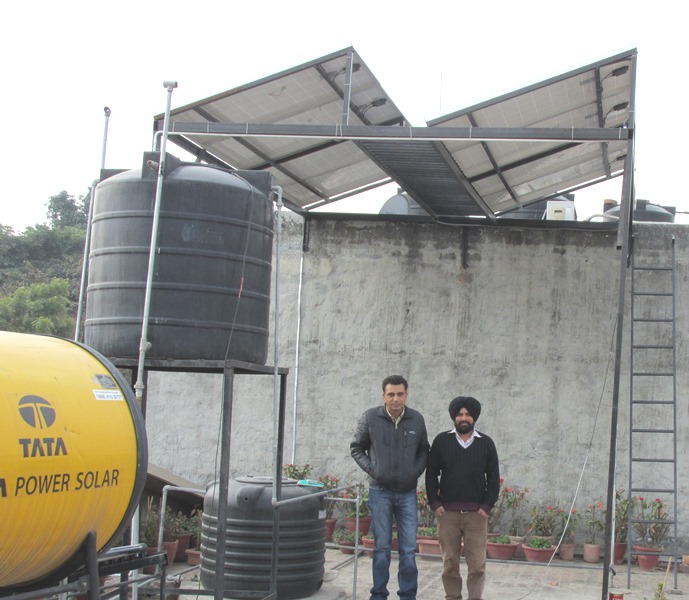
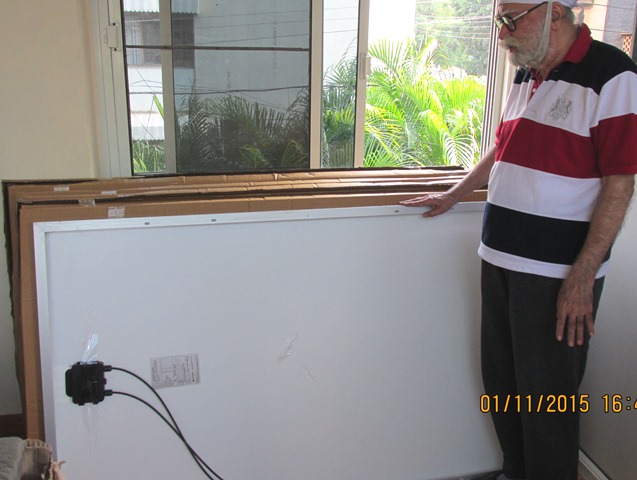
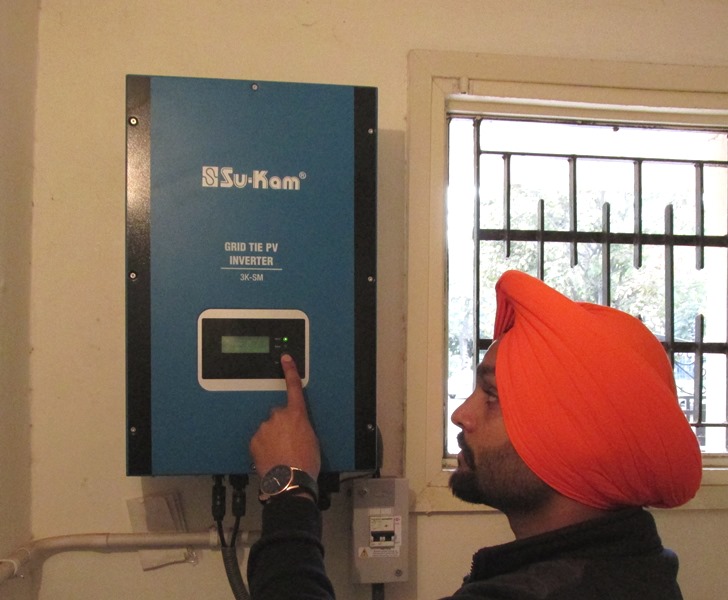
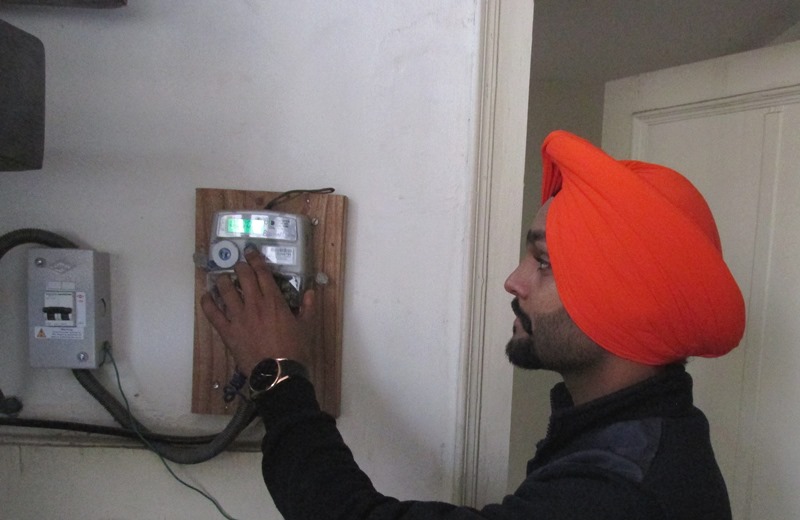
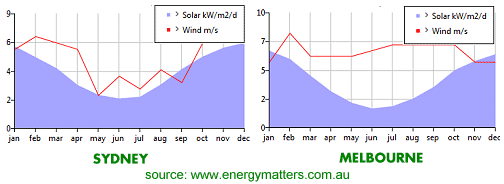



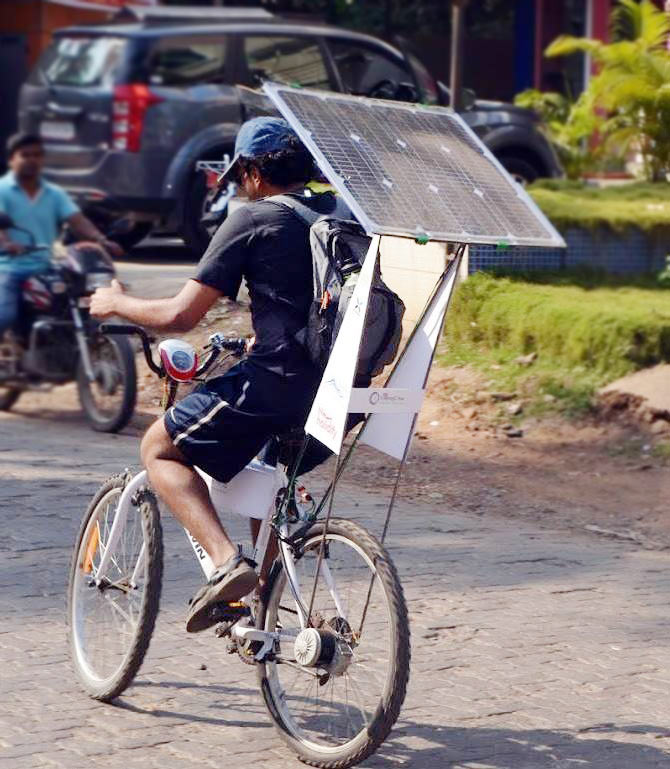






String inverters, microinverters, or power optimizers?
See
https://cleantechnica.com/2017/04/23/solar-panels-prices-installation-installers/
Jo,
Thanks.
There is a lot of information in this. I think that after a few more inputs, you may consider sending a full piece for the blog.
Surjit
Our intrepid solar cyclist sets a world record of 7424 km
http://www.deccanchronicle.com/lifestyle/viral-and-trending/291216/cyclist-sets-world-record-after-cycling-for-7-424-km-with-solar-panel.html
Great.
The solar energy programme is on schedule.
Thanks for this input
SS
US energy chief makes bold claim for storage technology
http://www.powerengineeringint.com/articles/2016/08/us-energy-chief-makes-bold-claim-for-storage-technology.html
Some ongoing research projects for improving storage efficiency of renewable power :
http://arpa-e.energy.gov/?q=projects%2Fsearch-projects&field_program_tid=All&field_project_state_value=MA&term_node_tid_depth=1018&field_project_status_value=All
The home of tomorrow will run on direct current
http://www.mnn.com/green-tech/research-innovations/stories/the-home-of-tomorrow-will-run-on-direct-current
Inverter less systems
http://www.cygni.com/products-2/
DC Appliances
http://www.cygni.com/products-2/
Chandigarh gets an award for the city with maximum installed solar power.
http://www.tribuneindia.com/news/chandigarh/governance/city-gets-two-awards-for-solar-energy/246190.html
Congrats to the author for being a leader in installing solar power in Chandigarh.
Thanks.
SS
An interesting development is hybrid solar air conditioners. See http://onyxsolarac.com/index.php
[...] Source: TAME THE SUN ON YOUR ROOFTOP « Guftagu @ amolak.in [...]
[...] TAME THE SUN ON YOUR ROOFTOP March 8, 2016 [...]
Dear General,
I am greatly impressed with your initiative in harnessing of solar power
broughtout in your writeup forwarded to me by old friend Gen.Coomar.
I cannot resist requesting for more details on the mini project suggested
by you (2kw?) setup.
I talked to my course mate who taught in CME Elec School, even he remarked ,yours as great initiative,productive and useful.
We both would like to learn about Soler panel- battery -and inverter configuration ,so that I could tryout a small set up on top of the prefab const.planned on the rooftop.
With regards
R M Singh.
Well Done.
Whats the Cost ?
Any subsidy from the Govt ? and
What it would cost for 5 KW ?
Dear Adlakha,
As a rule of the thumb, it costs Rs 75,000 to Rs 1,00,000 per Kwp
Government gives a subsidy of 30% but the procedure is quite tedious.
You need about 80 to 100 sq ft of roof space for every Kwp.
Regards for Sunita ji
Surjit
Subsidy is now harming the growth of solar. The govt announces subsidy but does not allot sufficient funds. So subsidy gets delayed. The irony is that solar is now cheaper than grid power and subsidy is not required. Many states give a higher price when they buy unsubsidized solar power. That is a better solution.
The irony is that the government subsidizes coal based power.
Karnataka has an extremely favourable net-metering policy (the most attractive in the country). Not only do you save costs, when you generate excess electricity, you get paid at Rs. 9.56 per unit.
Also, do keep in mind that this policy would be revised soon wherein the tariff may be lowered. If you manage to sign the PPA with BESCOM ASAP, the Rs. 9.56/unit will be applicable for 25 years.
The lesson is “Hurry up. The early bird gets the worm!”
Surjit
My dear Surjit
I read with interest your write up on roof top solar elec generation system. I did not find the size of solar panels, may be I havs missed it.
With best wishes,
Col Surinder Kumar ( sapper)
SK,
The size of the panels varies from 80 to 100 square feet per Kwp
Surjit
Good to see that you are always open to new experiments.
A very practical approach sir.
warm regards
lalit
Sir,
You are always kind with your words!
Surjit
Wow congratulations!
Dear Ms Bilimoria,
Thanks.
You can do your bit by passing the information to your friends. This is a good social cause!
Surjit
Thanks for a good advice.
Some 3 years ago I put up a 80 W photo-voltaic panel to provide a kind of trickle chargjng of an inverter running off a 150 Ah battery. Thru a controller this is connected to one phase. In the daytime when the sun is shining well, the controller runs the phase from the inverter. Of course the load should not exceed some 2-3 lights and fans. Perhaps I need to augment with a couple of more such panels so that the capacity/staying power is improved. The investment is minimal.
I am not looking at your kind of system, which could run into lakhs. Perhaps in the city there is no choice. I have trees all around the house and these provide some relief from the hot sun.
LED lights are basically DC devices. And a 150 Ah battery can run a lot of LED lights. You can run them directly off the battery. Get the LED lights sold for torches or cars.
Each time you convert DC to AC or vice versa, you lose some power. Since solar produces DC, try to use maximum DC devices.
Dear Surjit,
Many thanks for sharing this information.
Regards,
Harindar
Dear Harinar,
The need of the hour is to spread this message. If there are lots of rooftop panels, we will have less power cuts.
Regards,
Surjit
Sir,
Could you please ask your contractor to contact me for installing PV system at my home .
Regards,
Harwant
Dear Brig Harwant,
I have asked my contractor to get in touch with you.
The phone number of Angrez Singh is 09872193675
Regards,
Surjit
Weldone. Sujit, at last some one has done it. Will be in touch with you when we go in for this improvement.
Regards
Pami Bawa, Alpha Squadron, NDA
Dear Bawa,
Who can ever forget our ‘bronze’ winner PS Bawa. Here, we often talk about you as the brightest amongst the “A,B and C” of the XIX course.
Incidentally, PSS Chadha is in Chandigarh, and his house is in the same sector as mine. We meet him, often.
Regards,
Surjit
Thank you Surjit for sharing with us very informative information
Dear Uncle,
Its been a long long time since I have said hello to you. I was thinking of making a telephone call and later when I got the news that all went on well during the stent process, later again it skipped out of my mind to call back. Hope you are doing well, right now. Please take care!!
Your article about solar power is really great. I just wanted to find out how much did the whole unit costed.
With lots of love…
Venki,
Thanks. Come and see it for yourself!
The cost of my project was Rs 2.15 lakhs. The prices of the panels are decreasing.
Surjit
Thanks. I am forwarding the write up to my Society.
Regards
Veteran AVM RP Mishra
Dear Gen Surjit
Thank you so much for your email. Will explore and get back to you should I need further advice.
Best Regards
Colonel AK Ram Singh
Ashwani,
We shall be glad to answer your queries.
Wish you Godspeed!
Surjit
Dear Sir,
What you are suggesting appears to be a solution for the current lack of Elecrtric supply in Bhaarat.
But I do feel we must consider that the climate is Natural (and changing very slowly day after day) and our body is surely able to cope up the climate change by keeping with it all along. As we know cold kills more people in the world than (even) hot spells like heat wave. I am attaching the IANS news item (based on LANCET article) published in Moneylife dated 21 May 2015.
Everyone (including entities of living species) in the world is safe under Nature. When we do something against nature it may get annoyed and that should not be allowed to happen, don;t you also agree sir?
With regards,
——Mukund Apte
Mukund,
Yes I agree. Ecological balance has to be central to all our actions.
For more energy, if we install thermal plants, we will be polluting (and heating) the environment. Hydel plants take away a lot of land, and many people have to be re-located.
Solar and wind do not cause any of these.
Surjit
Thank you Sir
regards
Harikumar
Thanks for Sharing
Dear Genera
excellent project if one is living on the outskirts of the city or farm area,etc.
Here in Pune we have already a concrete jungle–6 & 7 storey apartments all around us–they have gobbled up all the sunlight & only they can have the solar system right on top so if anyone has a small house sandwiched between these giants such projects are futile—-nobody in town planning could have thought of this problem like all the others !
Warm regards,
Zal Kabraji.
Zal Kabraji,
For those who are interested in nation building, the advice is “Do not wait for government to act…you lead, and the others will follow.
Surjit
Very encouraging indeed. Saw plenty in Gujarat.
Delhi is lagging in this area. Hope we pick up here too.
(Copy of a mail sent by the general to his address list)
An enlightening and useful post by a veteran Maj Gen Surjit Singh. As always he continues to serve the others.
Do read and act if you are convinced.
Ashok Coomar
Dear Sir,
Thanks for the detailed and informative write up.
It was very interesting indeed and I am sure of following it up for my house.
Regards,
Arumugam.
Armugam,
Wish you Godspeed!
Surjit
Great!
An excellent hobby post retirement.
Surinder
Brother,
Thanks. In the absence of any other worthwhile activity, the computer is a ‘safe refuge’!
Surjit
Dear Sir,
What a lucid explanation of installing a small solar power plant for the house. The grid rates are reducing constantly as Rajasthan is exploiting this power in a huge way. From Jodhpur to Jaisalmer all the major corporate houses have got into this business.
As for households your plant is the best.
Thanks for this informative piece.
Thanks Neeraj.
I think 512 has enough land and wind to install a ‘hybrid’ system. You may like to moot a project, or alternatively, just go for it!
Regards,
Surjit
With overcast sky during most of the days in rainy season in Kerala, the output will be much less than in Chandigarh. But solar power is useful there as power cuts are frequent. Will try when we go there
You should fix solar + small wind turbine + controller + battery + inverter. That will take care of the cloudy days + power cuts.
Use a DC circuit for LED lights and for any other DC equipment you can get. For eg Railways use DC fans.
Su-Kam has dealers all over Kerala
Luminous Renewable Energy Solutions Private Limited is a company that can give you both wind & solar
ADDRESS
Gate No. 1569 / B, Vadki Village, Opposite Pune, Saswad Road
Pune – 412308
Maharashtra, India
Phone +91-8042909159
Get estimates from 2- 3 different companies and you will quickly see the optimum.
We have 3 KW solar panels installed over my home roof. Excess power it
generates during the day is fed back to the grid. However the infeed rates
to the grid are 1/3 of the buy rates from the electricity supply company.
As such we maximise use of solar power during the day (specially pre and
after noons) by running the A/C system, washing m/c, drier, dish washer,
etc.
Waiting for a cost effective battery system so that we can store excess
solar power generated instead of feeding it to the grid.
Power scene over the coming years will certainly change incl all electric
cars (instead of fossil fuel and hybrids) coming in the market. Great new
world!!
Balraj,
Do share the details of your system with our readers. Send us all the specifications, cost elements and the benefits derived by you, with pictures. We will carry it on our post.
Surjit
I had installed a solar module of 50 watts capacity with a bty to store power in 2003 for lighting only. This system is being used to light up eight electronic small lights, when there is a power power failure. The light output from each light is almost equal to the 20 watts tube light, and the bty support is four to five hours depending upon the number of lights on. I have used dc wires for maximum power efficiency. I had to replace the byt in 2008 that costed Rs 12000/, where as the total system cost in 2003 was Rs 30,000. The state govt gave Rs 10,000 as subsidy in 2003 that reduced the investment to Rs 20,000 in Bangalore. The system installed by Brig Surjit Singh is the best and it is economical to middle income groups. I would be upgrading into two kilowatts system, as I am looking for improved modules in a year or so. Yes, I agree that India is on self reliant sooner than expected by using solar .
The need of the hour is to:
a. Study the systems
b. Any one who has a roof and the money must install a system
c. Share the experience with others.
Surjit
Very educative even more inspiring.
Congrats and Thanks Surjit.
Presentation is superb.
Sukhdev,
Thanks for the kind words!
I hope this piece motivates some friends to install such systems.
Surjit
An enlightening post which can be very useful for most of us.
Thanks Sir.
Great to read and as usual a great learning from you Sir.
Good to see how you are gainfully engaged in enlightening others.
Thanks & Regards
Dhiraj
Dhiraj,
In Sikkim we used to try micro hydel projects. This is an extension of the same quest.
In Punjabi, they say,
“Waris Shah aadatan jandian nahin, bhawen katiye poria poria ”
Surjit
I have had 2 kwp solar for over two years ; since upgraded to 3 kwp. Working well. Being a PBI veteran did not indulge in elaborate cost-benefit analysis. A mere staff check to tide over the irritating power-cuts and the scary scenarios of climate change motivated a bold command decision. Not even a beneficiary of OROP- only rgret in life ‘working one’s butt-off to earn aan apex grade!
Thanks for an illuminating post!
Sir,
Vow!
That is called a ‘command decision’
Surjit
Congratulations!
I JUST COMMISSIONED MY 20 kWh ON MARCH 7.
In Delhi the costs are much lower. It is Rs. 74000 per Kwh.
Subsidy is 30 percent.
Just read a big ad in the paper that Solar initiative has already has an installed capacity of 5500 mega watts. Impressive.
Must do for all of us.
I got it done from a company and the email is anuj@eightmins.com They install all over India.
DNS,
Congrats. You are always on the forefront of change.
We will be happy to carry the news, with pictures, and all the relevant details of your installation with our readers.
Surjit
Dear Sir,
Is it enough to cover all requirements including ac etc?
Assuming that you have one AC and it requires 2 Kw power, you need to install about 5 Kwp solar panels. (Kwp stands for peak power)
If you have an independent house, the optimum is to have a small wind turbine plus solar.
Luminous Renewable Energy Solutions Private Limited is a company that can give you both wind & solar. Address :
Gate No. 1569 / B, Vadki Village, Opposite Pune – Saswad Road
Pune – 412308
Maharashtra, India
Phone +91-8042909159
Borg Energy is a solar company that is present in Chennai, Bangalore & Delhi.
An internet search will give you many contractors in Hyderabad also. Tata Solar alone has six dealers in Hyderabad. See http://www.tatapowersolar.com/Find-Dealer
Get estimates from 2 – 3 companies and you’ll get a good idea.
YOU SIRe…. R LIVIN IN A Palace ….MAHAL….
How about financing our small falat
We will pay u in inch-stalments
I am only 75 years and hopefully
OROP
will take care of me
ha ha okay one more ha!
one AC should do
for us two
guests should bear the heat as usual
Dear Bhai Sahib,
All that is mine is yours. Come and bless our ‘gharibkhana’
Surjit
I missed it
Will next time
if we stay in India
for summer
so far we are in
Dentals
dilly dally
they have to
many a tooth marry
So Sad
I’m Sorry
Bhai Vir ji
Regards ji
also bahurani ji
will not miss the opportunity
thanks to both of thee
colls me
There is an interesting talk explaining why the world will be 100 % on renewable power (mostly solar) before 2030 and also on 100 % electric cars, mostly driverless. See http://tonyseba.com/keynote-at-altcar-expo-100-electric-transportation-100-solar-by-2030/
In India, solar is already competitive with grid power. It is the beginning of the end of power generation from fossil fuels.
We are at the beginning of an explosive growth in distributed generation of power from rooftops. In a year or two, there will be no shortage of power.
Surjit has already said that he will issue an addendum to take into account the NDA government’s increase in the target for solar generation capacity to 100 GW by 2022. The Power Minister, Mr Piyush Goyal, is trying hard to achieve this target by 2019 itself.
When we were taught nuclear physics, we learnt about the ‘critical mass’ theory. As soon as the mass attains the ‘critical’ level, the reaction becomes unstoppable.
A similar phenomenon occurs when the aircraft attains the take off speed.
In social phenomena also a similar thing occurs. We saw that happen to ‘cell phones’ To begin with the mobile phone companies had to aggressively ‘sell’ the concept. But within three years, the movement attained the ‘take off speed…and then there was no stopping!
Thomas and I believe that we shall soon attain that stage in India. But some of us must install these devices, and TALK ABOUT THEM.
Surjit